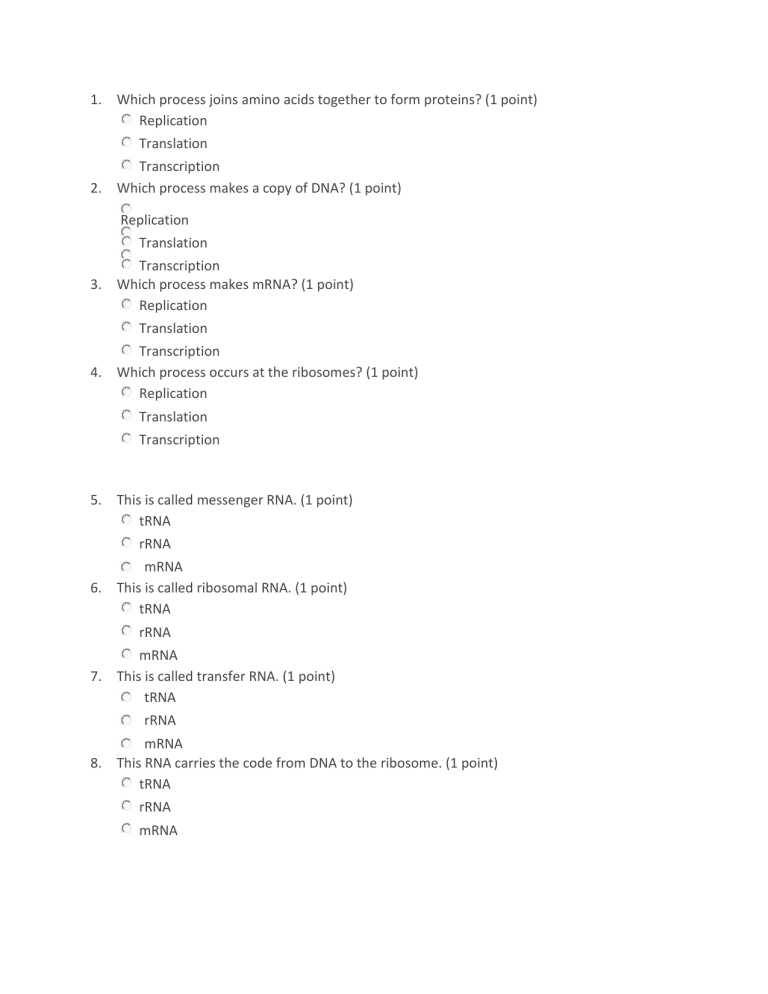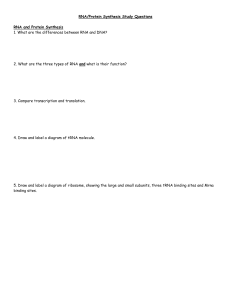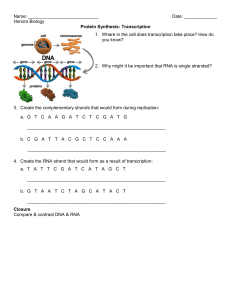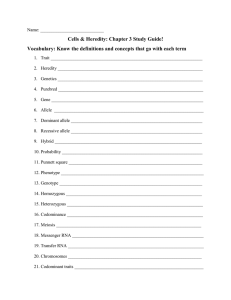Biology Worksheet: Protein Synthesis & Genetics
advertisement

1. Which process joins amino acids together to form proteins? (1 point) Replication Translation Transcription 2. Which process makes a copy of DNA? (1 point) Replication Translation Transcription 3. Which process makes mRNA? (1 point) Replication Translation Transcription 4. Which process occurs at the ribosomes? (1 point) Replication Translation Transcription 5. This is called messenger RNA. (1 point) tRNA rRNA mRNA 6. This is called ribosomal RNA. (1 point) tRNA rRNA mRNA 7. This is called transfer RNA. (1 point) tRNA rRNA mRNA 8. This RNA carries the code from DNA to the ribosome. (1 point) tRNA rRNA mRNA 9. This RNA joins the amino acids together at the ribosome. (1 point) tRNA rRNA mRNA 10. RNA contains which sugar? (1 point) Deoxyribose Ribose Factors that control traits are called a. genes. 11) b. purebreds. c. recessives. d. parents. Scientists call an organism that has two different alleles for a trait a a. hybrid. 12. b. trait. c. purebred. d. factor. 13. What does the notation TT mean to geneticists? a. two dominant alleles b. two recessive alleles c. at least one dominant allele d. one dominant and one recessive allelle 14. What does the notation Tt mean to geneticists? a. two dominant alleles b. two recessive alleles c. at least one recessive allele d. one dominant allele and one recessive allelle 15. What is probability? a. the actual results from a series of events b. the likelihood that a particular event will occur c. the way the results of one event affect the next event d. the number of times a coin lands heads up 16. What does a Punnett square show? a. all the possible outcomes of a genetic cross b. only the dominant alleles in a genetic cross c. only the recessive alleles in a genetic cross d. all of Mendel’s discoveries about genetic crosses 17. If a homozygous black guinea pig (BB) is crossed with a homozygous white guinea pig (bb), what is the probability that an offspring will have black fur? a. 25 percent b. 50 percent c. 75 percent d. 100 percent 18. An organism’s physical appearance is its a. genotype. b. phenotype. c. codominance. d. heterozygous. 19. What is a mutation? a. any change that is harmful to an organism b. any change in a gene or chromosome c. any change that is helpful to an organism d. any change in the phenotype of a cell 20. Which term refers to physical characteristics that are studied in genetics? a. traits b. offspring c. generations d. hybrids 21. The stages of meiosis are classified into two divisions: meiosis I and meiosis II. Compare and contrast these two divisions. 22. Contrast the functions of the three main types of RNA. 23. What must happen to a DNA molecule before RNA polymerase can make RNA? Figure 11–7 24. Inferring What do the letters R and I represent in Figure 11-7?


